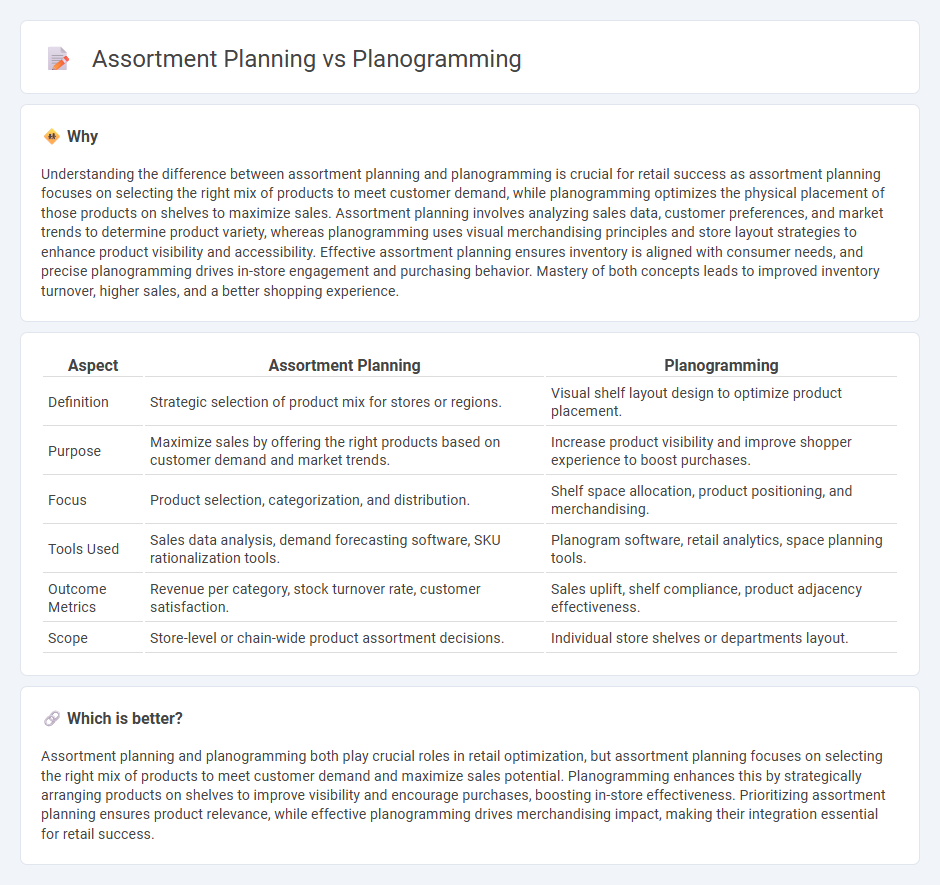
Assortment planning focuses on selecting the right mix of products to meet customer demand and maximize sales, while planogramming strategically arranges these products within the retail space to enhance visibility and shopper experience. Effective assortment planning analyzes market trends and consumer preferences, whereas planogramming optimizes shelf placement based on space constraints and product performance. Explore how mastering both strategies can significantly boost retail efficiency and profitability.
Why it is important
Understanding the difference between assortment planning and planogramming is crucial for retail success as assortment planning focuses on selecting the right mix of products to meet customer demand, while planogramming optimizes the physical placement of those products on shelves to maximize sales. Assortment planning involves analyzing sales data, customer preferences, and market trends to determine product variety, whereas planogramming uses visual merchandising principles and store layout strategies to enhance product visibility and accessibility. Effective assortment planning ensures inventory is aligned with consumer needs, and precise planogramming drives in-store engagement and purchasing behavior. Mastery of both concepts leads to improved inventory turnover, higher sales, and a better shopping experience.
Comparison Table
| Aspect | Assortment Planning | Planogramming |
|---|---|---|
| Definition | Strategic selection of product mix for stores or regions. | Visual shelf layout design to optimize product placement. |
| Purpose | Maximize sales by offering the right products based on customer demand and market trends. | Increase product visibility and improve shopper experience to boost purchases. |
| Focus | Product selection, categorization, and distribution. | Shelf space allocation, product positioning, and merchandising. |
| Tools Used | Sales data analysis, demand forecasting software, SKU rationalization tools. | Planogram software, retail analytics, space planning tools. |
| Outcome Metrics | Revenue per category, stock turnover rate, customer satisfaction. | Sales uplift, shelf compliance, product adjacency effectiveness. |
| Scope | Store-level or chain-wide product assortment decisions. | Individual store shelves or departments layout. |
Which is better?
Assortment planning and planogramming both play crucial roles in retail optimization, but assortment planning focuses on selecting the right mix of products to meet customer demand and maximize sales potential. Planogramming enhances this by strategically arranging products on shelves to improve visibility and encourage purchases, boosting in-store effectiveness. Prioritizing assortment planning ensures product relevance, while effective planogramming drives merchandising impact, making their integration essential for retail success.
Connection
Assortment planning and planogramming are interconnected processes that optimize retail merchandising and product placement. Assortment planning determines the ideal product mix based on customer demand, sales data, and inventory levels, while planogramming translates this mix into a visual shelf layout that maximizes space and enhances shopper experience. Together, they drive sales performance by ensuring the right products are available and attractively displayed.
Key Terms
**Planogramming:**
Planogramming strategically arranges products on retail shelves to maximize space utilization and enhance product visibility, directly influencing shopper behavior and sales performance. This process relies on data-driven insights from consumer behavior, sales trends, and inventory levels to optimize product placement for increased profitability. Explore more to understand how planogramming boosts retail efficiency and customer engagement.
Shelf Layout
Planogramming focuses on the detailed visual arrangement of products on shelves to maximize space utilization and enhance shopper experience through optimized product placement. Assortment planning involves selecting the right mix of products to offer based on consumer demand, sales data, and market trends, ensuring the shelves contain the most relevant items. Explore how integrating both strategies can drive better retail performance and customer satisfaction.
Product Placement
Planogramming focuses on optimal product placement within retail spaces to maximize visibility and sales, utilizing visual merchandising and shelf space analytics. Assortment planning determines the selection and variety of products based on consumer demand, sales data, and market trends, ensuring the right mix of products is available. Explore detailed strategies and tools used in both planogramming and assortment planning to enhance retail performance.
Source and External Links
What is a Planogram? How To Create One and Types (2025) - Shopify - A planogram is a schematic tool used to plan retail store layouts focusing on product placement and displays, helping retailers optimize space, improve visual merchandising, ensure planogram compliance, and boost sales through better organization and inventory management.
What Is a Planogram? (With Definition, Benefits and Tips) | Indeed.com - A planogram is a detailed visual merchandising tool, often part of a larger plan, that specifies the layout of a store and the exact placement of products by aisle or display to create consistent and methodical product arrangements.
The store-specific retail planogram guide - RELEX Solutions - Retailers increasingly use store-specific planograms tailored to each store's unique sales, demand, and space characteristics, improving stock accuracy and merchandising effectiveness compared to cluster-based planograms applied uniformly across multiple stores.
 dowidth.com
dowidth.com